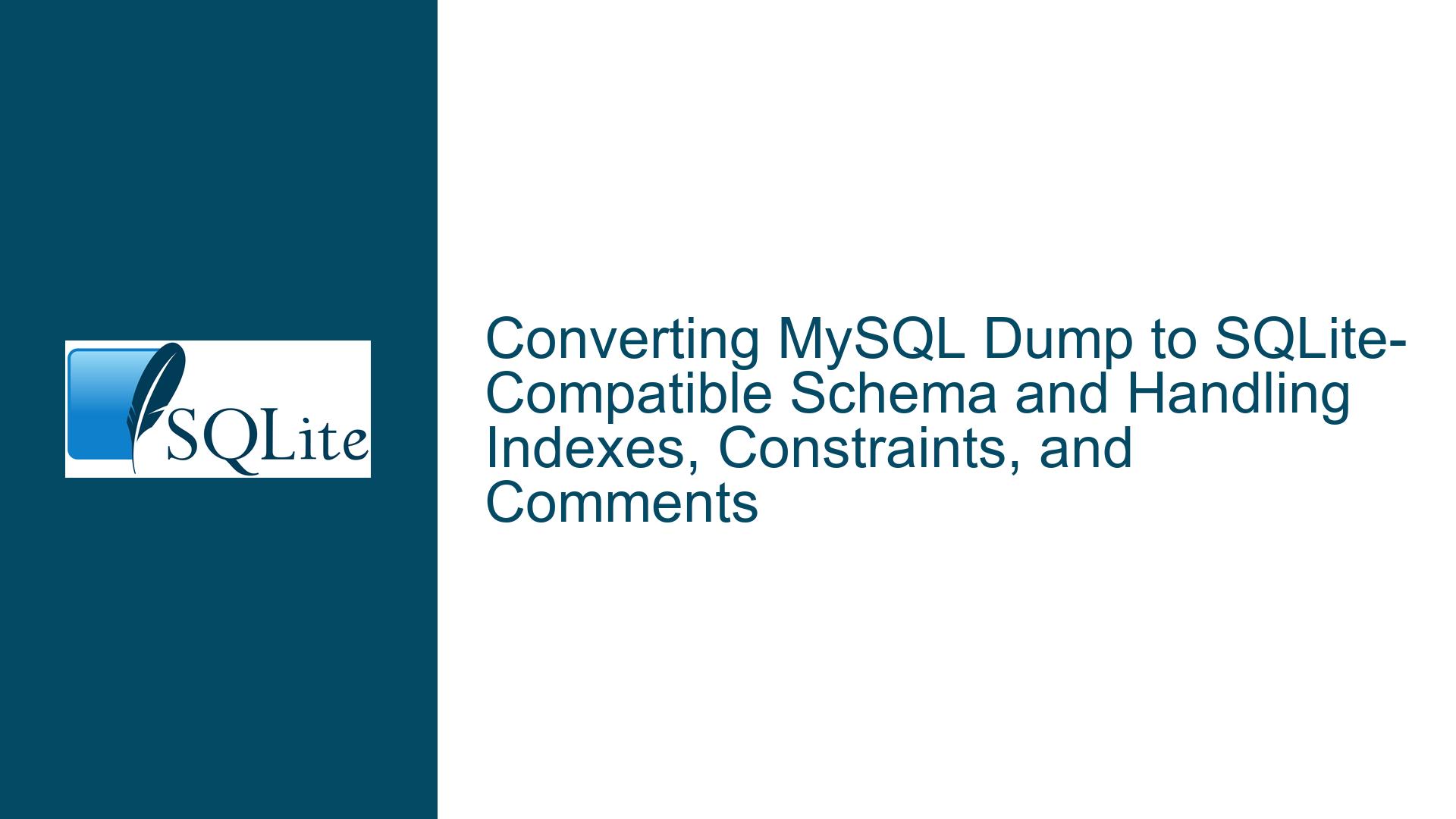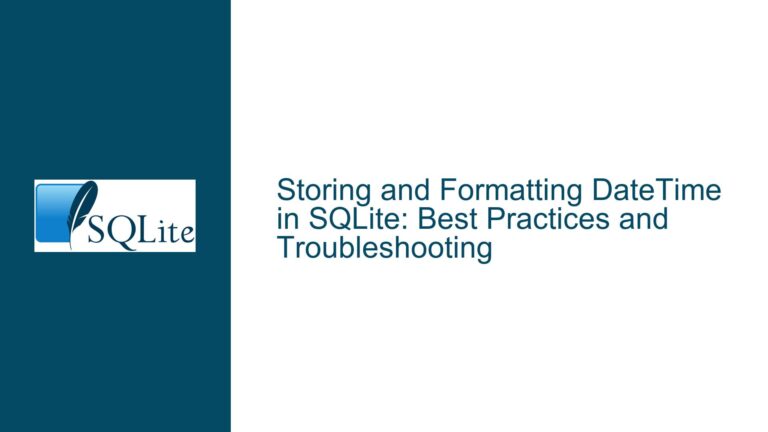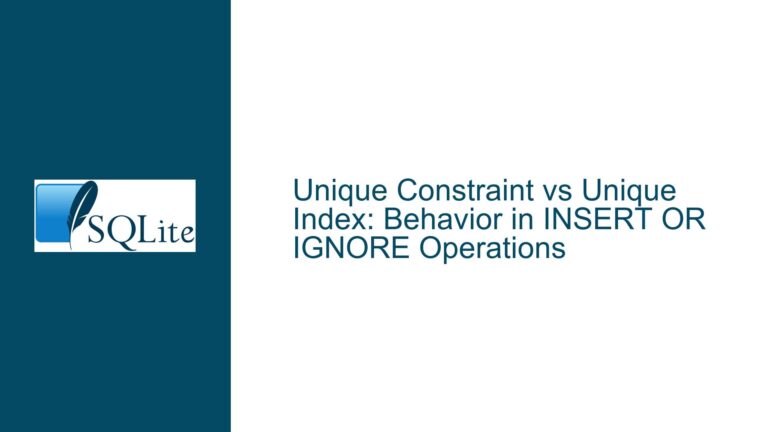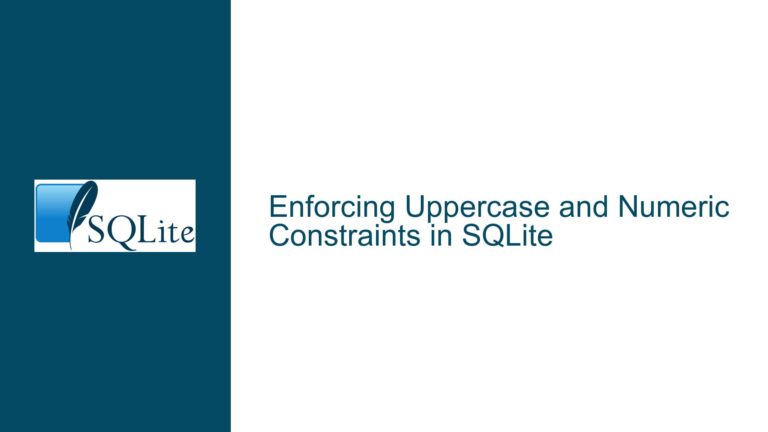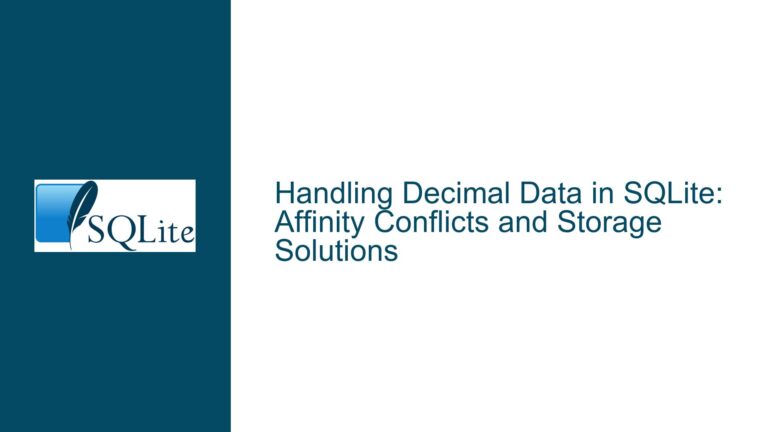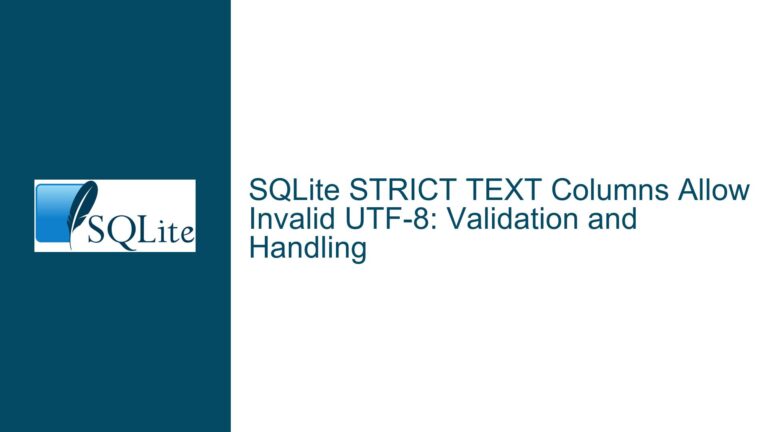Converting MySQL Dump to SQLite-Compatible Schema and Handling Indexes, Constraints, and Comments
Understanding the MySQL-to-SQLite Schema Conversion Challenge
When migrating a database schema from MySQL to SQLite, several key differences between the two database systems must be addressed. The primary issue in this scenario revolves around the incompatibility of certain MySQL-specific syntax and features with SQLite. Specifically, the challenges include:
- Index Creation Syntax: MySQL allows indexes to be defined inline within the
CREATE TABLEstatement, whereas SQLite requires indexes to be created separately usingCREATE INDEXstatements. - Column and Table Comments: MySQL supports a non-standard syntax for attaching comments to columns and tables directly within the
CREATE TABLEstatement. SQLite, however, does not support this syntax and only adheres to standard SQL comments (--or/* */). - Character Sets and Collations: MySQL uses specific character sets (e.g.,
utf8) and collations (e.g.,utf8_general_ci) that are not natively supported by SQLite. SQLite has a limited set of collations (BINARY,RTRIM, andNOCASE) and does not support the same character set definitions.
These differences necessitate a manual or automated translation process to convert the MySQL schema into a format that SQLite can accept. The goal is to ensure that the schema retains its structural integrity, including primary keys, indexes, and constraints, while adapting to SQLite’s limitations.
Identifying the Root Causes of Schema Incompatibility
The incompatibility between MySQL and SQLite schemas arises from several fundamental differences in how the two databases handle schema definitions and metadata. Below are the key causes of the issues highlighted in the discussion:
Inline Index Definitions in MySQL: MySQL allows indexes to be defined directly within the
CREATE TABLEstatement using syntax likeINDEX idx_name (column_name). This is convenient for MySQL users but is not supported by SQLite, which requires indexes to be created separately after the table is defined. This difference necessitates splitting theCREATE TABLEstatement into multiple statements: one for the table and additional ones for each index.Non-Standard Comment Syntax in MySQL: MySQL supports a proprietary syntax for attaching comments to columns and tables, such as
COMMENT 'comment text'. SQLite, on the other hand, only supports standard SQL comments (--or/* */), which are not stored as metadata in the schema. This means that any MySQL-specific comments must be either removed or converted into standard SQL comments, which will not be preserved in the SQLite schema.Unsupported Character Sets and Collations: MySQL’s support for character sets (e.g.,
utf8) and collations (e.g.,utf8_general_ci) is more extensive than SQLite’s. SQLite uses a simplified approach to text handling, with only three built-in collations (BINARY,RTRIM, andNOCASE). This means that any MySQL schema relying on specific character sets or collations must be adjusted to work within SQLite’s limitations.Schema Metadata Differences: MySQL stores extensive metadata about tables, columns, and indexes, including comments and character set information. SQLite’s metadata storage is more limited, focusing primarily on the structural aspects of the schema. This difference affects how schema information is preserved during the migration process.
Understanding these root causes is essential for developing a strategy to convert the MySQL schema into a format that SQLite can accept. The next section outlines the steps required to address these issues and achieve a successful migration.
Step-by-Step Troubleshooting and Schema Conversion Process
To convert a MySQL schema exported via mysqldump into a format compatible with SQLite, follow these detailed steps:
Step 1: Parse the MySQL Dump File
Begin by examining the MySQL dump file to identify all elements that need modification. Look for the following:
- Inline index definitions within
CREATE TABLEstatements. - MySQL-specific column and table comments.
- Character set and collation specifications.
For example, the provided MySQL dump contains the following CREATE TABLE statement:
CREATE TABLE `onl_cgform_button` (
`ID` varchar(32) CHARACTER SET utf8 COLLATE utf8_general_ci NOT NULL COMMENT '主键ID',
`BUTTON_CODE` varchar(50) CHARACTER SET utf8 COLLATE utf8_general_ci NULL DEFAULT NULL COMMENT '按钮编码',
...
PRIMARY KEY (`ID`) USING BTREE,
INDEX `idx_ocb_CGFORM_HEAD_ID`(`CGFORM_HEAD_ID`) USING BTREE,
...
) ENGINE = InnoDB CHARACTER SET = utf8 COLLATE = utf8_general_ci COMMENT = 'Online表单自定义按钮' ROW_FORMAT = Dynamic;
Step 2: Separate Index Definitions
SQLite does not support inline index definitions. Extract all index definitions from the CREATE TABLE statement and convert them into separate CREATE INDEX statements. For example:
CREATE TABLE `onl_cgform_button` (
`ID` varchar(32) NOT NULL,
`BUTTON_CODE` varchar(50) NULL DEFAULT NULL,
...
PRIMARY KEY (`ID`)
);
CREATE INDEX `idx_ocb_CGFORM_HEAD_ID` ON `onl_cgform_button` (`CGFORM_HEAD_ID`);
CREATE INDEX `idx_ocb_BUTTON_CODE` ON `onl_cgform_button` (`BUTTON_CODE`);
...
Step 3: Remove MySQL-Specific Comments
SQLite does not support MySQL’s COMMENT syntax. Remove or convert these comments into standard SQL comments. For example:
-- Original MySQL syntax
`ID` varchar(32) NOT NULL COMMENT '主键ID',
-- Converted for SQLite
`ID` varchar(32) NOT NULL, -- 主键ID
Step 4: Handle Character Sets and Collations
SQLite does not support MySQL’s character set and collation specifications. Remove these clauses from the schema. For example:
-- Original MySQL syntax
`ID` varchar(32) CHARACTER SET utf8 COLLATE utf8_general_ci NOT NULL,
-- Converted for SQLite
`ID` varchar(32) NOT NULL,
Step 5: Validate the Converted Schema
After making the necessary modifications, validate the schema to ensure it adheres to SQLite’s syntax rules. Use the SQLite command-line tool or a GUI like DB Browser for SQLite to test the schema.
Step 6: Automate the Conversion Process (Optional)
For large or complex schemas, consider using a script or tool to automate the conversion process. Several open-source tools and libraries are available for converting MySQL schemas to SQLite-compatible formats. Examples include:
mysql2sqlite: A Perl script that converts MySQL dump files to SQLite-compatible SQL.sqlalchemy: A Python library that can be used to programmatically convert schemas between different database systems.
Step 7: Import the Converted Schema into SQLite
Once the schema has been converted, use the SQLite command-line tool or a GUI to import the schema and data. For example:
sqlite3 mydatabase.db < converted_schema.sql
By following these steps, you can successfully convert a MySQL schema into a format that SQLite can accept, ensuring a smooth migration process.
In summary, the key to resolving the MySQL-to-SQLite schema conversion issue lies in understanding the differences between the two systems and systematically addressing each incompatibility. By separating index definitions, removing unsupported syntax, and validating the converted schema, you can achieve a seamless migration. For large-scale migrations, leveraging automation tools can further streamline the process.
